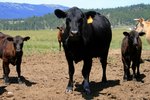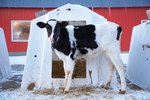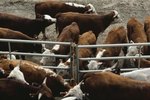Feeder and stocker steers are terms used for cattle in certain growth stages and beef production steps. These terms also apply to heifers that will not join the cow herd because of undesirable breeding traits or because the producer has to downsize his herd. Feeder and stocker heifers go through the same stages of meat production as the steers.
Stockers
The University of Kentucky describes a stocker calf as a steer or heifer that is six to nine months of age and weighs 400 to 700 pounds. After weaning from its dam, a stocker is put on grass or some other type of forage to promote growth and weight gain. Some producers like to fatten cattle for harvest strictly on grass, and their calves will stay in the stocker stage until they are harvested.
Feeders
A feeder calf is defined by the University of Kentucky as a steer or heifer weighing between 800 to 1,000 pounds and is one to two years of age. Feeders are usually stockers that are sold to feedyards for further weight gain. If a rancher produces large heavy calves, they may go directly from the ranch into the feeder stage and the stocker step is omitted. Feeders stay in a feedyard for four to six months prior to harvest. They are harvested at about 1,200 to 1,400 pounds and 18 to 22 months of age.
Stocker Program Objectives
The primary purpose of the stocker program is to prepare calves for the feedlot. This preparation is referred to as backgrounding or preconditioning. Although these calves are on pasture, they are given small amounts of supplemental feed to teach them to eat balanced rations. They are given vaccines and medicines to protect them against influenza and pneumonia type diseases and internal parasites such as stomach worms. When stockers leave the program, they are healthy and have become accustom to mixing with calves from other herds.
Feeder Program Operations
Cattle are grouped by age and size when they arrive at the feedyard. Each group is put in a pen that provides space or socializing and excercise. They are fed rations balnced by a professional animal nutritionist and their health is monitored daily by employees and a consulting veterinarian. The time that cattle spend in a feedyard is often called the finishing phase.
References
- University of Kentucky Agripedia; "Stocker Calf"
- University of Kentucky Agripedia; "Feeder Steer or Heifer"
- Mississippi State University; Stocker Production in Mississippi; Blair McKinley, Jane Parish, Richard Watson, John Anderson, Terry Engelken and Brad White; August 2004
- Cattlemen's Beef Board and National Cattlemen's Beef Association; Modern Beef Production Fact Sheet; September 2009
Photo Credits
-
Photos.com/Photos.com/Getty Images





